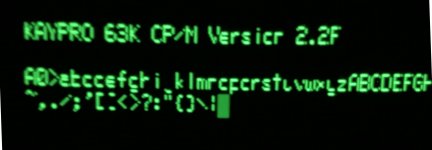Formulator
Experienced Member
I have a Kaypro 4/84 Plus 88. It is exhibiting a new issue in which some of the characters appear broken, particularly on the right side of each character, and some have portions that appear more dim as well. I have attached a sample image of the display. This is again a new issue and has not occurred before. It has been about a year since it the unit was last powered on. Please let me know if anyone else has had this issue before, and if it was solved. Thanks.




